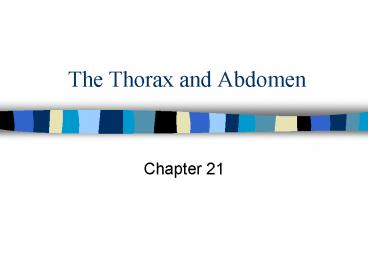The Thorax and Abdomen - PowerPoint PPT Presentation
1 / 20
Title:
The Thorax and Abdomen
Description:
Signs and Symptoms. shortness of breath, chest pain. may have absence of breath, ... Appendicitis. Spleen Contusion. Recognition and Management of Specific ... – PowerPoint PPT presentation
Number of Views:108
Avg rating:3.0/5.0
Title: The Thorax and Abdomen
1
The Thorax and Abdomen
- Chapter 21
2
Anatomy of Thorax
- Thoracic Cavity
- Ribs, Costal Cartilage, and Sternum
- Thoracic Muscles
- Lungs
- Respiratory Muscles
- Blood Supply
- Heart
- blood supply
- Thymus
- Abdominal Muscles
- Abdominal Viscera
3
Preventing/Assessing Injuries to Thorax and
Abdomen
- History
- Observation
- Palpation
- Abdomen - ausculation and percussion
- Special Tests
4
Preventing Injuries to Thorax and Abdomen
- Appropriate protective equipment
- Abdominal muscle strengthening
- Empty hollow organs before competition
5
Assessing Injuries to Thorax and Abdomen
- History
- What happened?
- Direct blow or contact?
- What was body position at time of injury?
- Type of pain, immediate or gradual?
- Location of pain?
- Difficulty breathing?
- Position of comfort?
- Feel faint?
- Light headed?
- Nauseated?
- Sounds?
- Muscle spasm?
- Blood in urine?
- Difficulty urinating?
- Was bladder empty?
- When was last meal?
- Look at History of family and other injuries.
6
Assessing Injuries to Thorax and Abdomen
- Observations
- Is athlete breathing?
- Having difficulty breathing?
- Pain with breathing?
- Position of athlete, holding chest?
- Look for symmetry of chest movement during
breathing.
- deformity,
- muscle spasm
- coughing up blood?,
- cyanosis?
- Other colouring of face or injury area.
7
Assessing Injuries to Thorax and Abdomen
- Palpations
- Feel surrounding structures.
- Bone changes
- Muscle and attachments
- Ligaments and attachments
- Spasm
- Bleeding
- pulses
- Special Tests
- Ausculation
- Percussion
- Rebound
8
Recognition and Management of Specific Injuries
- Rib Contusion
- Rib Fracture
- Costochondral Separation and Dislocations
- Sternum Fracture
- Muscle Injuries
- Breast Injury
9
Rib Contusion
- Etiology
- Blow to rib cage - bruise to intercostal muscles
or to rib or fracture to rib - Signs and Symptoms
- Pain on inspiration and expiration
- Sharp pain when rib cage is compressed
- Point tenderness (local)
- Management
- X-ray examination, PIER, anti-inflammatory,
rest
10
Rib Fracture
Etiology Highest incidence in collision sports,
caused by direct and indirect trauma, may be
result of violent muscle contraction, sneezing -
ribs 5-9 are commonly injured Signs and
Symptoms Severe pain on inspiration point
tenderness, crepitus, palpable deformity if
spring outward, collapse of lung Management
X-ray exam, support and rest
11
Costochondral Separation and Dislocations
- Etiology
- direct blow to anterolateral aspect of thorax or
indirectly from sudden twist or fall that
compresses rib cage - Signs and Symptoms
- sharp pain during sudden movement
- difficulty breathing deeply
- point tenderness over costal cartilage
- deformity
- crepitus
- Management
- X-ray, rest, support, PIER
12
Recognition and Management of Specific Injuries
- Injuries to the Lungs
- Pneumothorax
- Hemothorax
- Traumatic Asphyxias
- Heart Contusion
- Sudden Death Syndrome
- Abdominal Injuries
- Kidney Contusions
- Kidney Stones
13
Pneumothorax
- Etiology
- hole in chest allowing air to fill the pelural
cavity - space between pleural membrane and lung
- causing the lung to be compressed and collaps
- Signs and Symptoms
- Pain
- difficulty breathing
- anoxia
- Management
- EAP
- cover hole on three sides with plastic
14
Tension Pneumothorax
- Etiology
- air fills pleural sac on one side
- displacing the lung and heart toward the opposite
side - eventually compressing the opposite lung
- Signs and Symptoms
- shortness of breath, chest pain
- may have absence of breath,
- cyanosis, distension of neck veins,
- deviation of trachea away from side of injury
- collapse of lungs
- Management
- EAP
15
Heamothorax
- Etiology
- presence of blood within the pleural cavity
- resulting from puncture or tearing of lung or
pleural tissue - may be caused by rib fracture
- Signs and Symptoms
- severe pain
- difficulty breathing
- Cyanosis
- coughing up frothy blood
- shock
- Management
- EAP
16
Heart Contusion
- Etiology
- Compression of heart between spine and sternum
- strong outside force.
- Signs and Symptoms
- Severe shock and heart pain.
- May have heart arrhythmias leading to decreased
cardiac output. - death.
- Management
- CPR
- treat for shock
- EAP
17
Kidney Contusion
- Etiology
- blow to lower back
- degree of injury is a result of the degree of
engorgement of the kidney - Severe shock and heart pain.
- May have heart arrhythmias leading to decreased
cardiac output. - death.
- Signs and Symptoms
- Shock
- Nausea
- Vomiting
- rigidity in back muscles
- blood in the urine
- referred pain into upper back and lower abdomen
- Management
- have athlete urinate two or three times if blood
is present refer - immediately to physician, may require surgery
18
Recognition and Management of Specific Injuries
of the Abdomen
- Contusion of Ureters, Bladder, and Urethera
- Cystitis
- Hernia
- Urinary Tract Infection
- Urethritis
- Contusion of Abdominal Wall
- Gastrointestinal Bleeding
- Indigestion (Dyspepsia)
- Solar Plexus stitch in side
- Food Poisoning
- Peptic Ulcer
19
Recognition and Management of Specific Injuries
of the Abdomen
- Liver Contusion
- Pancreatitis
- Diarrhea
- Hemorrhoids
- Constipation
- Appendicitis
- Spleen Contusion
20
Recognition and Management of Specific Injuries
ofReproductive Organs
- Scrotal Contusion
- Spermatic Cord Torsion
- Contusion of Female Genitalia
- Vaginitis





















![[PDF] Multi-Detector CT Imaging Handbook, Two Volume Set 1st Edition Full PowerPoint PPT Presentation](https://s3.amazonaws.com/images.powershow.com/10082307.th0.jpg?_=20240720068)
![[PDF] Multi-Detector CT Imaging Handbook, Two Volume Set 1st Edition Full PowerPoint PPT Presentation](https://s3.amazonaws.com/images.powershow.com/10082466.th0.jpg?_=20240720119)








